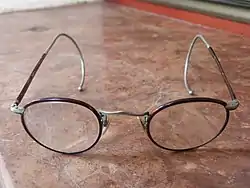眼鏡
Chinese
| eye | mirror; lens | ||
|---|---|---|---|
| trad. (眼鏡) | 眼 | 鏡 | |
| simp. (眼镜) | 眼 | 镜 | |
Etymology
Attested in the late Ming Dynasty:
- 靉靆即眼鏡。 [Classical Chinese, trad.]
- From: late Ming Dynasty, 張自烈, 正字通 (Zhèngzìtōng)
- Àidài jí yǎnjìng. [Pinyin]
- 靉靆 (àidài, “glasses”) is equal to 眼鏡 (yǎnjìng, “glasses”).
叆叇即眼镜。 [Classical Chinese, simp.]
Pronunciation
Noun
眼鏡
Synonyms
Derived terms
Descendants
Japanese
Etymology 1
| Kanji in this term | |
|---|---|
| 眼 | 鏡 |
| め Grade: 5 |
かね > がね Grade: 4 |
| kun’yomi | irregular |

Probably originally a compound of 目 (me, “eye”) + 金 (kane, “metal”, in reference to the metal used in eyeglass frames). The kane changes to gane as an instance of rendaku (連濁). The spelling is based on an apparent borrowing from Chinese, see the gankyō reading below.
Appears in texts from the late 1500s.[1]
Derived terms
- お眼鏡 (o-megane, “(honorific) judgement”)
- 眼鏡絵 (megane e, “painting designed to be viewed through a special type of glasses”)
- 眼鏡越し (meganegoshi, “seeing through glasses”)
- 眼鏡猿 (meganezaru)
- 眼鏡違い (megane chigai, “misjudgement”)
- 眼鏡橋 (meganebashi)
- 眼鏡蛇 (megane hebi)
- 雪眼鏡 (yuki megane, “snow goggles”)
- 色眼鏡 (iro megane)
- 蟹眼鏡 (kani megane, “a kind of binocular for use on a cannon”)
- 絡繰り眼鏡 (karakuri megane, “peep show”)
- 黒眼鏡 (kuro megane)
- 水中眼鏡 (suichū megane, “hydroscope, water glass, swimming goggles”)
- 伊達眼鏡 (date megane)
- 塵除け眼鏡 (chiriyoke megane, “protection glasses”)
- 遠眼鏡 (tōmegane)
- 錦眼鏡 (nishiki megane, “kaleidoscope”)
- 覗き眼鏡 (nozoki megane, “peep show; water glass”)
- 箱眼鏡 (hako megane, “water glass”)
- 鼻眼鏡 (hana megane, “pince-nez”)
- 百色眼鏡 (hyakuiro megane, “kaleidoscope”)
- 百眼鏡 (hyaku megane, “kaleidoscope”)
- 股眼鏡 (mata megane, “looking through or between one's legs”)
- 水眼鏡 (mizu megane, “swimming goggles”)
- 虫眼鏡 (mushi megane)
- ロイド眼鏡 (roido megane, “thick round celluloid glasses”)
Idioms
- 眼鏡が狂う (megane ga kuruu)
- 眼鏡にかなう (megane ni kanau)
Descendants
- Korean: 메가나 (megana)
Etymology 2
| Kanji in this term | |
|---|---|
| 眼 | 鏡 |
| がん Grade: 5 |
きょう Grade: 4 |
| kan’on | goon |
/ɡankjau/ → /ɡankjɔː/ → /ɡankjoː/
Probably a borrowing from written Chinese 眼鏡/眼镜 (yǎnjìng). Eyeglasses are first mentioned in Chinese in the 1400s as 靉靆/叆叇 (aidai?), a transcription of an Arabic term. By the late Ming dynasty, eyeglasses appear in writing as 靉靆即眼鏡/叆叇即眼镜 (“aidai, i.e. eye-lenses”), using the compound term 眼鏡/眼镜 (yǎnjìng, literally “eye + lens”). Compare modern Min Nan reading gán-kiàⁿ.
This reading appears in texts from the 1920s.[1]
Usage notes
This reading was mostly used by the military.[1] The standalone term gankyō may be somewhat archaic now.
Note that there are compounds that end in 眼鏡 (gankyō) that appear to be derived from this term. However, Japanese sources parse these as deriving from other terms ending in 眼 (gan, “eye”) that are then suffixed with 鏡 (kyō, “lens”).
See also
- 遠眼鏡 (engankyō, “glasses to correct farsightedness”)
- 近眼鏡 (kingankyō, “glasses to correct nearsightedness”)
- 検眼鏡 (kengankyō, “ophthalmoscope”)
- 双眼鏡 (sōgankyō)
- 天眼鏡 (tengankyō, “magnifying glass”)
- 両眼鏡 (ryōgankyō)
- 老眼鏡 (rōgankyō, “reading glasses”)
Okinawan
Etymology 1
Cognate with mainland Japanese 眼鏡 (gankyō), ultimately deriving from written Chinese 眼鏡/眼镜 (yǎnjìng). Eyeglasses are first mentioned in Chinese in the 1400s as 靉靆/叆叇 (aidai?), a transcription of an Arabic term. By the late Ming dynasty, eyeglasses appear in writing as 靉靆即眼鏡/叆叇即眼镜 (“aidai, i.e. eye-lenses”), using the compound term 眼鏡/眼镜 (yǎnjìng, literally “eye + lens”). Compare modern Min Nan reading gán-kiàⁿ.
Derived terms
- 目眼鏡 (mīganchō)